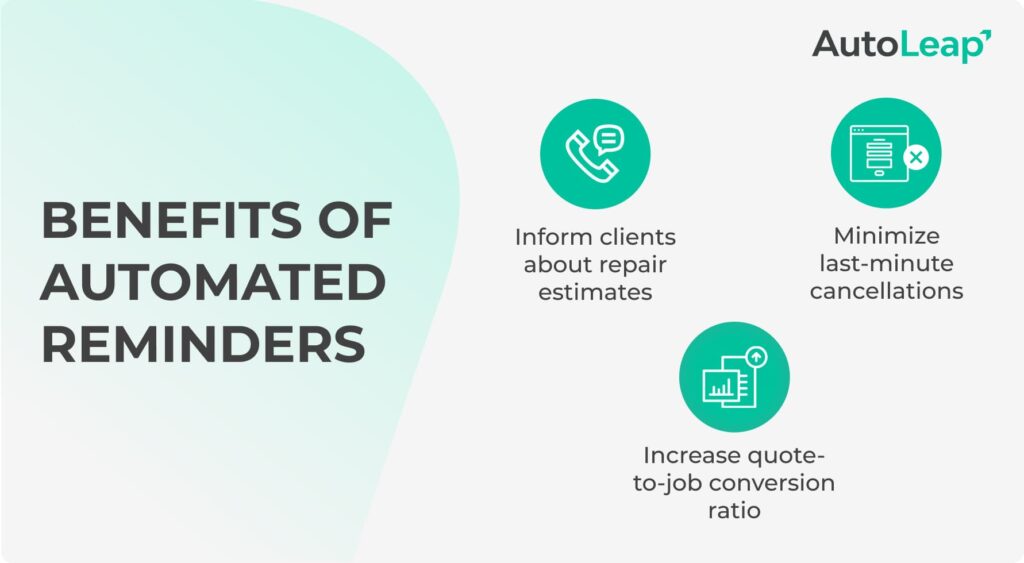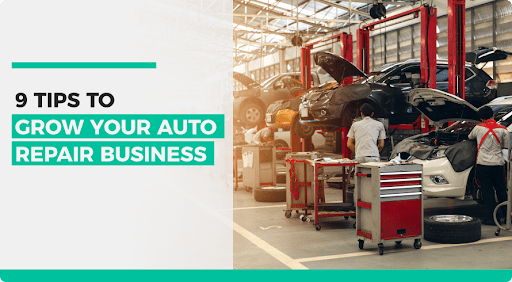Unlike other businesses, auto repair shops are at the back of peoples’ minds until something goes wrong. Some people have a go-to trusted mechanic, but most turn to Google to decide where to take their car for repair issues.
We’ve done the research, and here are the 9 most impactful things your team can do to become the shop of choice in your neighborhood.
1. Set up your business website
Schedule a free demo today!

Boost your shop sales

Simplify shop management

Empower your technicians
If you don’t have a business website yet, your team needs one—now! The vast majority of car owners today are under 40, and only interact with businesses that they can find online. The most compelling auto repair shop websites have:
- A list of the services they provide
- Contact information, displayed front and center (include your location PIN for customers viewing your website on their mobiles)
- Fast load times
- Mobile-friendly designs
- Relevant content (think blogs and tips)
- Customer reviews (pro tip: you can import Google Reviews to your website)
2. Use local SEO to increase website traffic
When you Google something, how likely are you to scroll down and click on the second, let alone third page of results to find what you’re looking for?
When a prospective customer searches for “weird exhaust sound” or “auto shops near me”, you’d want your website to show up at the top. This is where local Search Engine Optimization (SEO) comes in; if this sounds too technical, don’t worry—there are tons of SEO experts out there ready to help.
According to Google, websites that rank higher are likely to get 70% more clicks, which directly affects the amount of traffic (potential customers) you get on the site and leads to higher conversions rates (a prospect who clicks on the site, interacts with it and eventually becomes a customer).
3. Ask for reviews
4. Partner with other local businesses
Your auto repair shop might not be the only small business in the area that’s competing against bigger corporations. Your next door café or neighborhood mom-and-pop grocery store might be facing an equally tough time from a larger store.
For example, you could set up a mutually beneficial affiliation with the café, where you would advertise the café to your customer base and in return, they would get a discount at the café for showing a receipt from your shop! And vice versa.
5. Voucher advertising
Who doesn’t like free stuff?
Vouchers (or coupons) are a cost effective, yet impactful option which you could explore to attract new customers. These also help your customers stay on top of easy-to-forget, but critical maintenance services for their cars. You could include offers such as:
- Free 10-point inspection with an oil change.
- Free oil change with a safety test.
Get more paid jobs and increase your ticket size.
Include vouchers in your regular communications with customers. An email newsletter is one area you can feature these coupons and incentivize visits to your shop.
6. Use the latest automotive technology
Amp up the customer experience at your shop with vehicle inspection software.
DVI equips auto technicians with the power of multimedia (photos and videos) to point out exactly what needs to be fixed. It will give your customers a deeper sense of understanding, allowing them to make an informed decision about the auto repairs recommended by your car repair business.
Tech-savvy shop owners can increase their average ticket size by 30% or more with these modern automotive tools, DVI being just one such example. Digital vehicle inspections are a must-have for all auto repair shops to build customer trust and increase their average repair order size.
7. Send automated reminders
Did you ever imagine that something as simple as reminders could help you make more money?
- Reduce customer no-shows (and increase revenue) by sending automated appointment reminders via text and email to customers.
- Send automated reminders for repair estimates that require authorization, and increase your quote-to-job conversion ratio.

Ensure recurring revenue from your existing customers and take your business to the next level.
8. Maintenance reminders
Kill two birds with one stone by sending maintenance reminders to your customers. Your customers enjoy more peace of mind on the road, and you enjoy a stable base of repeat business for your shop—truly a win-win!
Service reminders show loyal customers that you care about them and their cars, making you stand out from the competition. Using the latest in auto shop management software
allows your team to save deferred maintenance & services and automate the follow-up process with customers—even if you forget, your customers will still get reminders!
9. Loyalty programs
Offer a loyalty (or VIP) program for your regular customers; this will serve as an incentive for them to keep using you for their auto repair needs. Customers love rewards! For example:
- You could provide a free oil change for every five fully-paid oil changes.
- Or you could offer a coupon for a free car-wash for every $X spent at your shop, and in return, have the car-wash advertise your business to their customers!
How to grow auto repair business 101: More strategies to consider
Social media branding
Social media can feel like a big obligation, especially when it comes to managing your channels. But to create a brand that resonates with customers, an active social presence is critical.
Here are some social media tips to grow your automotive industry brand:
- Share customer experiences: Potential customers will want to hear about the experience at your shop. Promote the five-star experiences your customers share in their reviews across every social media platform. Make sure these reviews are detailed and speak to what someone can expect if they schedule an appointment.
- Share your offers: If you are running an exciting special or have a game-changing new offer, make that promotion known across social platforms!
- Include interactive posts: Get your page visitors involved! Run polls that ask them questions about their past service experiences. Ask interesting questions that are more likely to generate engagement.
- Provide value: Not every post should center around your shop. Share thought leadership on winter vehicle tips you compiled into a recent blog post. Build trust by providing value without asking for anything in return.
Word-of-mouth marketing
Spending marketing dollars on digital strategies has its appeal, but even old-school approaches can work. Word-of-mouth marketing is a simple yet effective way to promote your shop.
Print out your business card and carry it everywhere with you. Spread the word about your shop to friends, family, past work colleagues and anyone you come across. If the conversation is relevant, bring up the shop and share your contact information. Attend auto repair conferences and trade shows to promote your business.
These interactions, however minor, can add up and help you grow in the auto repair industry. Don’t ignore the upside of word-of-mouth referrals.
Waiting lounge amenities
Customers love complementary services. Premium amenities can really add to their experience at your shop. Not only will this lead to return visits, but they’ll definitely mention the set-up to friends and family. You may even see your waiting room highlights show up on social media feeds!
Here are some tips to make your shop’s waiting room stand out:
- Buy comfortable furniture and coffee tables
- Offer complimentary refreshments and snacks
- Provide free Wi-Fi and television
Email communication
Marketing emails are an important part of your shop’s growth strategy. With the right messaging, you can attract more customers for your shop’s repair services.
Remember these tips when crafting your email marketing campaigns:
- Use catchy subject lines: Email inboxes are filled with promotions and offers. To rise above this clutter, use an attention-grabbing subject line. Without something that resonates, it’s doubtful a potential customer even opens your email.
- Provide value: Similar to our social media recommendations, offer tangible value. Send out an email newsletter with tips on winter maintenance prep and strategies to improve vehicle upkeep. Don’t always just ask for something in your marketing materials.
- Don’t spam customers: Be strategic with how frequently you email your customers. Target the times they are most likely to open the email, preferably earlier in the week. But remember, even loyal customers won’t want to hear from their auto repair business all the time.
Closing thoughts
We have covered more than a few best practices on how to grow your auto repair business. While there’s no exact formula to follow, these tips will help you increase your revenue and become the preferred auto repair shop in your area.









